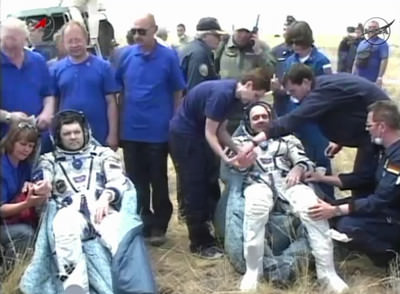We’re sure going to miss Don Pettit’s and Andre Kuipers’ reports and images from the International Space Station. Pettit, Kuipers and Russian Commander Oleg Kononenko undocked from the International Space Station and returned safely to Earth on July 1, wrapping up their six-and-a-half-month mission in orbit.
They landed in their Soyuz TMA-03M spacecraft in Kazakhstan at 08:14 a.m. UT (2:14 p.m. local time) after undocking from the space station’s Rassvet module at 04:47 UT. This video shows a great view of the Soyuz slowly drifting down (it’s interesting to see the parachute undulate, looking almost like a jellyfish!) and then visible are the breaking thrusters firing just a second before the hard landing.
The trio originally arrived at the station back on Dec. 23, 2011, and during this mission spent a total of 193 days in space, 191 of which were aboard the station.
During their expedition, the crew supported more than 200 scientific investigations involving more than 400 researchers around the world. The studies ranged from integrated investigations of the human cardiovascular and immune systems to fluid, flame and robotic research. They also were part of the team that successfully berthed the first commercial spacecraft to visit the ISS, the SpaceX Dragon capsule.
Before leaving the station, Kononenko handed over command of Expedition 32 to the Russian Federal Space Agency’s Gennady Padalka, who remains aboard the station with NASA astronaut Joe Acaba and Russian cosmonaut Sergei Revin. NASA astronaut Sunita Williams, Russian cosmonaut Yuri Malenchenko and Japan Aerospace Exploration Agency astronaut Akihiko Hoshide will join them July 17. Williams, Malenchenko and Hoshide are scheduled to launch July 14 from the Baikonur Cosmodrome in Kazakhstan.
During Expedition 31, Pettit used household objects aboard the station to perform a variety of unusual physics experiments for the video series “Science Off the Sphere,” like his recent video showing water balloons in space. Through these demonstrations, Pettit showed more than a million Internet viewers how space affects scientific principles.
On June 25, Pettit reached a milestone: spending one cumulative year in space, combining his time in orbit on Expedition 6, Expedition 30/31 and the STS-126 space shuttle Endeavour flight to the station in November 2008. Pettit now has 370 days in space, placing him fourth among U.S. space fliers for the longest time in space.
Kuipers conducted over 50 scientific experiments for ESA, and shared, almost daily, images and reports of his stay in space. The next ESA astronaut to board the Space Station is Luca Parmitano of Italy, who will fly on Soyuz TMA-09M in 2013 as member of Expedition 36/37.


“(it’s interesting to see the parachute undulate, looking almost like a jellyfish!)” DITTO! My thoughts EXACTLY. Welcome Ommmm you guys! GOOD JOB!
What exactly happened with Don Pettit? He was kept out of view when they were outside the capsule, because he was unconscious? Is he doing OK now?
And this is considered a “Swift Extraction”?? You’d think after 30+ years of Soyuz, they’d be more quick about it. How about some power tools to open the hatch?!!
That must be the most terrifying part of the mission! What a ridiculous performance. After 6 months floating in space you are manhandled out of the hatch, completely helpless, then shovelled down an 8 foot drop on a metal shute. How long before they drop one of them? Isn’t it beyond the bounds of possibility to get some sort of hoist and harness on them, to at least make it a bit more comfortable, not to mention, more safe?